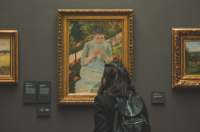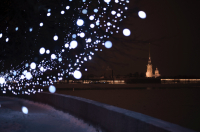Please tell, how did you become a clocksmith?
Well, I did not plan to become one. I graduated from LITMO's (former name of ITMO University) Optomechanical Instruments Department and started to work in that field. I got interested in clocks later, as a hobby: once I was asked to repair a broken clock. I tried and failed, but got interested in the subject. Later, my senior friend, Yuri Platonov (also LITMO's graduate) called me to work on the reconstruction of the tower clock of the Gatchina Grand Palace that suffered during the war. Then we worked with the clock of the Ferapontov Monastery and the tower clock of the Marble Palace. In the early 90-s we were contacted by the Hermitage Museum: they decided to create a Laboratory for Scientific Restoration of Timepieces and Musical Mechanisms, as there are more than three thousand of them in the museum's collection. At first, I did not agree to join it, as I was working in Kurchatov Institute in Gatchina, and it was really interesting there. Still, I left for the Hermitage in 1994 — the year our Laboratory was founded.
What are the professional and personal qualities a clocksmith has to possess? Are there many such specialists in the world?
I believe that as in any profession, loving your work is what’s most important. Still, there are particular qualities a clocksmith has to possess. First of all, a clocksmith has to have good eyesight, spatial perception, and be patient. Also, he has to be clever with hands. Generally, one learns the profession from senior masters; as for universities, I can only name West Dean College that I graduated from in 2000.
What about the number of clocksmiths, there are as many as necessary. Good clocksmiths work at antique clock shops, though they keep a low profile: antique clocks in good condition are valued a lot more than repaired ones. Also, many clocksmiths work for themselves.

Are there any "scientific principles" to clock restoration?
Restoration principles would be more correct. Theoretically speaking, all the changes we do should be reversible. For example, if I were to change a cog, I would have to keep the original one to put it back if necessary. Also, we have to document every step we take, so it would be easy to trace the whole process. We can't improve the construction itself.
How many Hermitage clocks did you and your team restore?
I've heard this question often, but I never counted. No less than two hundred, I believe. The range is wide: from tower clocks to ring watches. Our work is really interesting, diverse, as all clocks are different. There was no mass-production before. In addition, with time, every piece becomes more and more unique. They don't only have different cases, but also different clockworks who may have lots of problems that are hard to diagnose. So we don't get overconfident, as we face new challenges every time. Yet, after we've restored a clock, it almost never breaks again.
What makes clockworks so unique? Now there are atomic watches that give a one second deviation in a thousand years. Aren't those the great achievement of art and science?
Mechanical clocks appeared in 14th century as a plaything of tsars and emperors, and even now they are expensive toys of rich people. Once, best minds and talents worked on clockworks. So, they are a part of culture that has to be preserved. We do complex restoration, we stick to the artist's intentions, meaning to restore both the case and the mechanism.

The most beautiful and valuable part of the clock is the clockwork, but visitors don’t even see it. Is it important to tell people of the uniqueness of clockworks?
A museum is a specific structure: sometimes it's necessary to prove that the aesthetic beauty of clockworks is equal to that of art objects. When you're reading the description of clocks in the Hermitage, it's all about the case: its material, the master who did it, the style. This is ok. But the clockworks themselves are really diverse, interesting and beautiful. As for the tours, there's a lot to work with. For instance, there is such an exhibit as a 17th century astronomical clock. They are in the shape of a celestial globe, and show the position of stars, the sun and the moon. It sort of gives you the picture of the whole world, and you see the universe as if you were God. This sensation is unique, and is something to share. Also, this is simply beautiful.
Will it be hard to elaborate a tour on clockworks? And who would be interested in it?
The evening themed tours I see on Wednesdays are mostly attended by women. In some seven groups I saw only two men. Why? These tours are on art. Probably, that's not very interesting for many men. But technical things, clockworks, weapons and such, might be. This topic is still to be covered by the museum. I believe that masterpieces of technology are equal to those of art. Surely, such tours will call for a guide that knows of technology and engineering and can convey it to the visitors. Also, it's hard to show clockworks to the visitors, as they are hidden inside the case. Surely, we can make models of them or show videos. But there has to be some balance, so that such tours would be interesting to both children and adults.

Why do people love the Peacock Clock so much?
They move, so it's only natural, especially for children. And what is interesting to children is interesting to adults as well. "The Peacock" is spectacular, live, and mysterious in how it works. What's more, there are few working mechanical clocks from 18th century, and the Peacock is well-advertised.
Does every clock have a history to be told?
It's not always like this. Not all of the exhibits have remarkable past, but some have really unique history. For instance, Shtrasser's big clock was to be presented to the Chinese Emperor, as it was hard to find a buyer in Russia. Still, the expedition that was to take them to China turned back, and they were brought to the Hermitage. This clock is the biggest in Russia that has a mechanic organ.
Or the 18th century Conde Prince clock — it has six hands: the three standard ones, hands weekdays and a regular and moon calendars. During the French Revolution, the clock was lost, then was found again, bought for Paul the First, but while they were on the way to Russia, Paul was killed. In the end, the clock left in the Hermitage. Still, that was not the end of their adventures: after the revolution, they were disassembled to prevent them from being sold. In 2003, we reassembled them back, though we had to create several elements anew. Now, they are displayed at the museum. And the Arakcheev'sclock are made in such a way that they play music every day at the time of Alexander the First's death. There are lots of interesting clocks in the Hermitage.
From your point of view, what were the greatest inventions in the clockworks history?
In the 16th century, springs were introduced into the construction of clocks, so they have become portable. In the middle of 17th century, pendulums were introduced, which increased the time measurement accuracy. By the way, there is a great story about Galileo who invented the pendulum. During a service at a cathedral, he noticed that chandeliers swayed evenly and with different periods. He checked this with his own pulse. As a result, not only did he discover the equations to the pendulum motion, but also introduced new ideas into clockworks.

Who are interested in the Hermitage's clock collection the most?
Every year,clocksmiths from other countries come here — from Germany, England, the USA. Generally, they want to visit our workshop — it's a lot more interesting, as there the clocks are in disassembled state and one can look at how they work.
And if ITMO's graduates were to come work at your workshop?
Actually, the question of personnel is quite pressing for us. When we opened the Laboratory, we were already far from being young. We'll need someone to take our place, and as there are almost no establishments that train such specialists, we train who we can. We aren't against graduates having their internships here. Then, it will all depend on the person: will he like it? Is he any good? There's a lot that can be done here at the Laboratory.





